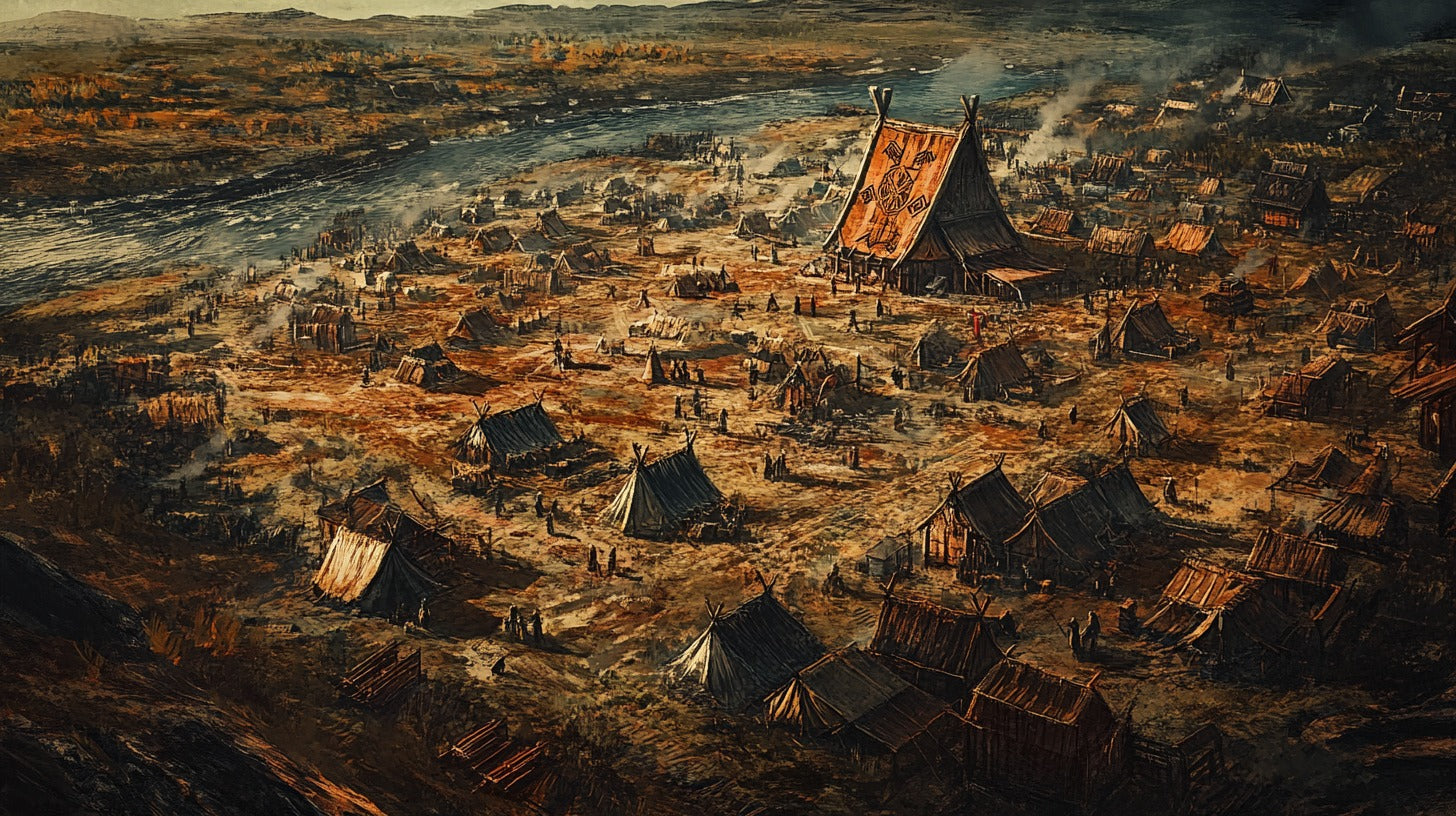
King Horik I: The Forgotten Architect of Early Danish Statehood
King Horik I, also known as Horik the Elder or Horik I Gudfredsson, was a prominent Danish monarch who ruled in the early to mid-9th century. His reign was marked by significant political, military, and religious developments that had lasting impacts on both Denmark and the broader European landscape. This article delves into the life, reign, and legacy of King Horik, exploring his role in shaping the Viking Age and his interactions with the expanding Frankish Empire.
Early Life and Ascension to Power

Horik I - 17th century engraving
King Horik was born into the royal lineage of Denmark, though the exact date of his birth remains uncertain. He was the son of King Gudfred, who ruled Denmark in the early 9th century and was known for his conflicts with Charlemagne's Frankish Empire. The Danish royal succession during this period was often complicated and contested, with multiple branches of the royal family vying for power.
Following the death of his father around 810 CE, Denmark entered a period of internal strife. Horik's path to the throne was not straightforward, as he had to contend with rival claimants, including his own relatives. According to the Frankish Royal Annals, Horik shared power with his brother or cousin, Hemming, for a time. However, by the 820s, Horik had emerged as the sole ruler of Denmark, consolidating his power and establishing himself as a formidable figure in Scandinavian politics.
Reign and Political Landscape
Horik's reign was characterized by efforts to centralize power and maintain control over the various chieftains and regional leaders within Denmark. The political structure of Viking Age Scandinavia was complex, with power often distributed among local rulers and influential families. Horik had to navigate these intricacies, balancing the interests of different factions while asserting his own authority.
Archaeological evidence from the period suggests a growing level of organization and centralization in Denmark during Horik's reign. The construction and maintenance of defensive structures, such as the Danevirke - a system of fortifications across the Jutland peninsula - indicate a level of coordinated effort and resources that point to a strengthening central authority.
Relations with Neighboring Kingdoms
Horik's rule coincided with a period of increasing interaction and conflict between Scandinavian kingdoms and their European neighbors. To the south, the expanding Frankish Empire under the successors of Charlemagne posed both a threat and an opportunity for diplomatic engagement. To the east, relations with other Scandinavian rulers, particularly those in Sweden and Norway, fluctuated between alliance and rivalry.
One of the most significant aspects of Horik's foreign policy was his dealings with the Franks. The Frankish chronicles, particularly the Annals of Fulda and the Annals of St. Bertin, provide valuable insights into these interactions, though they must be read with an awareness of their potential biases.
Conflict with the Franks
The relationship between Denmark and the Frankish Empire was tense throughout much of Horik's reign. This tension was a continuation of the conflicts that had marked his father Gudfred's rule. The Franks viewed the Danish Vikings as a significant threat to their northern borders and maritime interests.
In the 820s, there were several diplomatic exchanges between Horik and the Frankish rulers. These negotiations often centered around issues of trade, border security, and the activities of Viking raiders. While Horik sometimes presented himself as willing to curb Viking raids, the Franks often doubted his sincerity or ability to control all the Viking groups operating from Danish territories.
One of the most notable conflicts during Horik's reign occurred in 845 CE when a large Viking fleet, allegedly with Horik's blessing, attacked and sacked Hamburg. This city was an important center of the Frankish efforts to Christianize the north, and its destruction had significant repercussions.
In response to such raids, the Franks launched several punitive expeditions into Danish territory. These campaigns had mixed results, often leading to temporary peace agreements that were soon broken. The conflict between Denmark and the Frankish Empire remained unresolved throughout Horik's reign, contributing to the ongoing instability along the frontier between Scandinavia and continental Europe.
Viking Raids and Expansion

Horik's Role in Viking Activities
While King Horik's exact role in organizing and sanctioning Viking raids is debated among historians, it's clear that his reign coincided with a period of increased Viking activity across Europe. The Frankish sources often accused Horik of supporting or at least tacitly approving these raids, though Horik himself sometimes claimed to be trying to restrain the Viking warriors.
It's important to note that "Viking" was not a unified political entity but rather a term describing Scandinavian raiders and traders. Many of these groups operated independently of royal control, making it challenging for rulers like Horik to exert complete authority over their activities.
Impact on European Politics
The Viking raids and trading expeditions that intensified during Horik's reign had far-reaching consequences for European politics and economics. These activities contributed to the weakening of the Carolingian Empire, influenced the development of defensive strategies and fortifications in Western Europe, and opened up new trade routes that would shape medieval commerce.
Moreover, the Viking presence in various parts of Europe led to the establishment of Scandinavian settlements in places like Ireland, England, and parts of France (Normandy). While many of these developments extended beyond Horik's direct control or lifespan, they were part of the broader historical context in which his reign was situated.
Religious Tensions

Tiwaz Mjölnir Thor's Hammer Amulet
Paganism vs. Christianity
One of the most significant aspects of Horik's reign was the growing tension between traditional Norse paganism and the expanding influence of Christianity. Denmark in the 9th century was still predominantly pagan, with a rich mythology and religious tradition centered around gods like Odin, Thor, and Freya.
However, Christian missionaries, backed by the Frankish Empire, were increasingly active in Scandinavia during this period. The Frankish rulers saw the Christianization of Denmark as both a religious imperative and a political strategy to bring the Viking lands under their influence.
Interactions with Christian Missionaries
Horik's approach to Christianity appears to have been pragmatic and variable. In 831 CE, he allowed Ansgar, known as the "Apostle of the North," to establish a church in the trading center of Hedeby. This decision was likely motivated by political and economic considerations rather than religious conviction, as it helped facilitate trade with Christian merchants.
However, Horik's attitude towards Christianity was not consistently favorable. In 845 CE, following the Viking sack of Hamburg, many Christian churches in Denmark were reportedly destroyed. The Vita Ansgari, a hagiographical account of Ansgar's life, suggests that Horik later regretted this action and once again permitted Christian preaching in his realm.
These fluctuations in religious policy reflect the complex balancing act that Horik had to perform, managing internal pagan traditions and external Christian pressures.
Assassination and Legacy
Mounds part of the Danevirke defences
Circumstances of Horik's Death
King Horik's reign came to an end in 854 CE. The primary source for information about his death is the Annals of Fulda, a Frankish chronicle that provides a brief but significant entry for that year. The actual text from the Annals of Fulda, as translated by Timothy Reuter, states:
"Horic king of the Danes was killed by Gudurm his kinsman, and after him Horic the Younger received the kingdom." [1]
This terse account provides us with several key pieces of information: the year of Horik's death (854 CE), the manner of his death (he was killed), the perpetrator (Gudurm, described as his kinsman), and his successor (Horik the Younger). While the chronicle doesn't provide extensive details, it does confirm that Horik's death was violent and likely the result of internal power struggles within the Danish royal family.
Impact on Danish History
The death of Horik I marked a significant transition in Danish rulership. The ascension of Horik the Younger (sometimes referred to as Horik II) to the throne indicates a continuation of the same dynastic line, but likely under different power dynamics.
The brevity of the Annals' entry and the lack of detailed information about the aftermath suggest that the transition might not have had immediate dramatic effects visible to the Frankish chroniclers. However, the violent nature of the succession underscores the ongoing instability and competition for power within the Danish elite.
It's important to note that our understanding of this period is limited by the scarcity of contemporary Danish sources. Most of our information comes from foreign chroniclers, particularly Frankish ones, who may not have had a complete or unbiased view of events in Denmark. This limitation in sources means that many details of Horik's reign and its aftermath remain uncertain.
The aftermath of Horik's assassination likely saw a period of political reorganization in Denmark. The ascension of Horik the Younger suggests some continuity, but the violent nature of the succession may have weakened central authority and altered the balance of power among various factions within the kingdom.
Conclusion
King Horik I of Denmark remains a significant figure in 9th-century Scandinavian history, despite the limitations in our historical record. His reign, lasting several decades, saw Denmark navigate complex political, military, and religious challenges. The violent end to his rule, as recorded in the Annals of Fulda, provides a glimpse into the often turbulent nature of royal succession in Viking Age Scandinavia.
While we must be cautious about drawing too many specific conclusions given the limited sources, it's clear that Horik's reign and its aftermath were pivotal in shaping the political landscape of Denmark. The events surrounding his death highlight the ongoing process of state formation and the challenges faced by early medieval Scandinavian rulers in maintaining and transferring power.
Horik's legacy lies not just in the specific events of his rule, but in his role during a transformative period that saw increasing interaction between Scandinavia and the rest of Europe. His reign provides valuable insights into the political, social, and religious dynamics of the early Viking Age, setting the stage for the significant developments that would follow in Danish and broader Scandinavian history.
FAQ
- When did King Horik rule Denmark?
King Horik ruled Denmark in the early to mid-9th century, with his reign ending in 854 CE when he was assassinated.
- What was King Horik's relationship with Christianity?
Horik had a complex relationship with Christianity. He allowed some Christian missionaries to preach in Denmark but also oversaw the destruction of churches. His approach seems to have been primarily driven by political considerations rather than personal belief.
- Did King Horik lead Viking raids himself?
There's no clear historical evidence that Horik personally led Viking raids. However, he was accused by Frankish sources of supporting and sanctioning raids on their territories.
- How did King Horik die?
According to the Annals of Fulda, Horik was killed in 854 CE by Gudurm, described as his kinsman, likely during a power struggle within the Danish royal family.
- What was the significance of King Horik's reign for Danish history?
Horik's reign was significant for the consolidation of royal power in Denmark, the intensification of Viking activities, and the kingdom's increasing engagement with Christian Europe. His rule set important precedents for Denmark's political and cultural development in the Viking Age.
References
Reuter, Timothy (trans.) The Annals of Fulda. Manchester Medieval Sources Series, Ninth-Century Histories, Volume II. Manchester University Press, 1992.
"Danevirke 2" by Västgöten is licensed under CC BY-SA 3.0.








